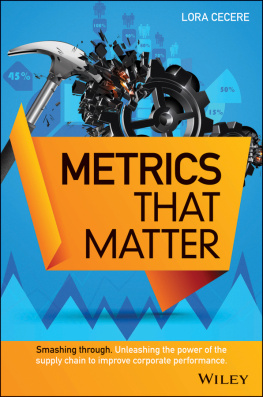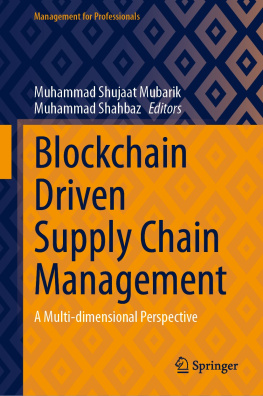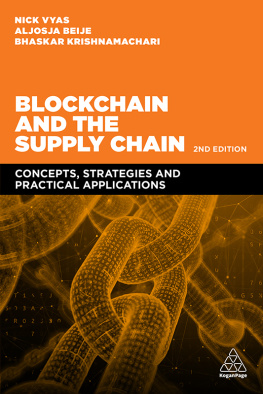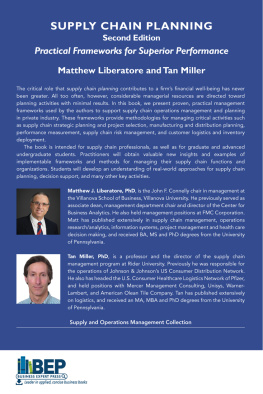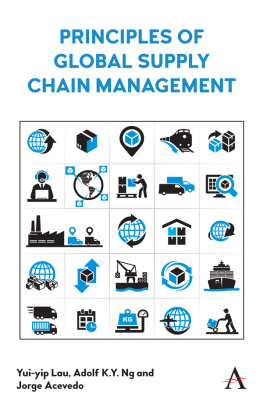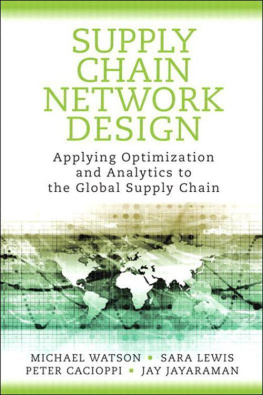
The Wiley Corporate F&A series provides information, tools, and insights to corporate professionals responsible for issues affecting the profitability of their company, from accounting and finance to internal controls and performance management.
Founded in 1807, JohnWiley & Sons is the oldest independent publishing company in the United States. With offices in North America, Europe, Asia, and Australia, Wiley is globally committed to developing and marketing print and electronic products and services for our customers professional and personal knowledge and understanding.
Cover Design and Image: C-Leveld, Pittsburgh, PA
Copyright 2015 by Lora M. Cecere. All rights reserved.
Published by John Wiley & Sons, Inc., Hoboken, New Jersey.
Published simultaneously in Canada.
No part of this publication may be reproduced, stored in a retrieval system, or transmitted in any form or by any means, electronic, mechanical, photocopying, recording, scanning, or otherwise, except as permitted under Section 107 or 108 of the 1976 United States Copyright Act, without either the prior written permission of the Publisher, or authorization through payment of the appropriate per-copy fee to the Copyright Clearance Center, Inc., 222 Rosewood Drive, Danvers, MA 01923, (978) 750-8400, fax (978) 646-8600, or on the Web at www.copyright.com. Requests to the Publisher for permission should be addressed to the Permissions Department, John Wiley & Sons, Inc., 111 River Street, Hoboken, NJ 07030, (201) 748-6011, fax (201) 748-6008, or online at http://www.wiley.com/go/permissions.
Limit of Liability/Disclaimer of Warranty: While the publisher and author have used their best efforts in preparing this book, they make no representations or warranties with respect to the accuracy or completeness of the contents of this book and specifically disclaim any implied warranties of merchantability or fitness for a particular purpose. No warranty may be created or extended by sales representatives or written sales materials. The advice and strategies contained herein may not be suitable for your situation. You should consult with a professional where appropriate. Neither the publisher nor author shall be liable for any loss of profit or any other commercial damages, including but not limited to special, incidental, consequential, or other damages.
For general information on our other products and services or for technical support, please contact our Customer Care Department within the United States at (800) 762-2974, outside the United States at (317) 572-3993 or fax (317) 572-4002.
Wiley publishes in a variety of print and electronic formats and by print-on-demand. Some material included with standard print versions of this book may not be included in e-books or in print-on-demand. If this book refers to media such as a CD or DVD that is not included in the version you purchased, you may download this material at booksupport.wiley.com. For more information about Wiley products, visit www.wiley.com.
Library of Congress Cataloging-in-Publication Data:
ISBN 9781118858110 (Hardcover)
ISBN 9781118938980 (ePDF)
ISBN 9781118938973 (ePub)
This book is dedicated to supply chain pioneers who forged the path for the supply chain management profession.
Foreword
My first exposure to the discipline of supply chain management was in the fall of 1969 when, as an undergraduate business major at the University of Notre Dame, I took an elective course in Physical Distribution Management. The text of the same name was by three pioneers: Donald J. Bowersox, Edward W. Smykay, and Bernard J. LaLonde. Less than a year later I would begin a PhD program in Business Logistics at The Ohio State University with the remarkable privilege of having Dr. Bud LaLonde as my program advisor and committee chair.
During the 1960s the academic discipline and eventual career path that would come to be known as supply chain management was effectively in its infancy. Textbooks were only beginning to appear, major fields of study were offered by only a few universities (a scandalous omission that persists to the present day), and the principal international organization of professionals had only recently been founded: the National Council of Physical Distribution Management (NCPDM), later renamed the Council of Logistics Management (CLM) and its present incarnation, the Council of Supply Chain Management Professionals (CSCMP). It was certainly a more innocent time for logisticians, for the management objective in those days was consistent with the course and book titles: balancing a limited set of finished goods distribution costs against selected customer service goals, and almost always for domestic firms.
It was not until 1982 that the term supply chain first appeared and it did not gain widespread use until the mid-1990s. But way back in 1963, something remarkable happened. Bud LaLonde did what he would continue to do for decades: he put forth a vision for the profession. In his view Physical Distribution Management should be married with Materials Management (procurement and manufacturing) and the whole thing should be called Business Logistics. Revolutionary? Absolutely. Accepted by the profession? Not a chance. Some 13 years later Michigan State researchers would introduce the term Integrated Logistics (procurement, manufacturing, and finished goods distribution under a single line-level executive) as one of the attributes for Leading Edge firms. In recent years, notably in the work by Professors Douglas Lambert, Martha Cooper, Keely Croxton, Thomas Goldsby et al. of The Ohio State University and the Global Supply Chain Forum, we have seen SCM developed using the very sophisticated perspective of cross-functional business process integration with relationship management as a key element.
So, five decades later, where are we? Sadly, for many companies not much better off than in the 1970s. We are still crippled by anachronistic functional silos, presided over by vice presidents who fiercely defend their worn-out turf and who measure and reward performance with an endless stream of silo initiatives and ever-changing performance metrics. Supply chain management may be the fashionable verbal coin of the realm, but far too often in practice it is currency that purchases relatively little. Where have we gone astray and what can be done about it?
Enter Lora M. Cecere. As a highly experienced software developer, consultant, and industry analyst she has a wealth of experience from which to draw. And draw she does, introducing the reader to a fictitious company populated with classic executives who are struggling to understand why overall corporate performance lags despite their relentless pursuit of typical performance metrics. In particular, there is a singular focus on growth objectives. Complicating matters further is an impending expansion into Brazil. The executives are all well-meaning, if functionally myopic at the outset. Here, Lora very effectively avoids the obvious trap of overplaying their characteristics to the point of caricature. Rather, at least in my experience, they are very accurately portrayed.
Very early on, Lora introduces the reader to the overarching theme of the book, which is also the title: Metrics That Matter. We learn that her selected measures are familiar enough to almost anyone in business, while at the same time we are disabused of a host of other, equally traditional measures. So where is the fundamental contribution? It is with the cross-functional (read that as corporate performance) interplay of the measures, the interactions that are notindeed cannotbe appreciated when one is focused on functional silo performance. It is in this context that we are introduced to the concept of the
Next page
